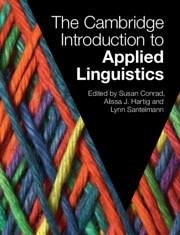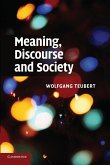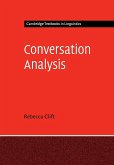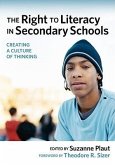The Cambridge Introduction to Applied Linguistics
Herausgeber: Conrad, Susan; Santelmann, Lynn; Hartig, Alissa
Schade – dieser Artikel ist leider ausverkauft. Sobald wir wissen, ob und wann der Artikel wieder verfügbar ist, informieren wir Sie an dieser Stelle.
The Cambridge Introduction to Applied Linguistics
Herausgeber: Conrad, Susan; Santelmann, Lynn; Hartig, Alissa
- Broschiertes Buch
- Merkliste
- Auf die Merkliste
- Bewerten Bewerten
- Teilen
- Produkt teilen
- Produkterinnerung
- Produkterinnerung
A comprehensive and up-to-date textbook that brings applied linguistics alive while preparing students for the field with hands-on practice.
Andere Kunden interessierten sich auch für
A comprehensive and up-to-date textbook that brings applied linguistics alive while preparing students for the field with hands-on practice.
Produktdetails
- Produktdetails
- Verlag: Cambridge University Press
- Seitenzahl: 414
- Erscheinungstermin: 30. Juli 2020
- Englisch
- Abmessung: 245mm x 192mm x 25mm
- Gewicht: 908g
- ISBN-13: 9781108455817
- ISBN-10: 1108455816
- Artikelnr.: 58818123
- Herstellerkennzeichnung
- Libri GmbH
- Europaallee 1
- 36244 Bad Hersfeld
- gpsr@libri.de
- Verlag: Cambridge University Press
- Seitenzahl: 414
- Erscheinungstermin: 30. Juli 2020
- Englisch
- Abmessung: 245mm x 192mm x 25mm
- Gewicht: 908g
- ISBN-13: 9781108455817
- ISBN-10: 1108455816
- Artikelnr.: 58818123
- Herstellerkennzeichnung
- Libri GmbH
- Europaallee 1
- 36244 Bad Hersfeld
- gpsr@libri.de
Portland State University
Part A. Introduction: 1. Introduction to the Field of Applied Linguistics
Susan Conrad, Alissa J. Hartig, and Lynn Santelmann; 2. Approaches to
Research in Applied Linguistics Alissa J. Hartig; Part B. Major Areas of
Focus within the Field of Applied Linguistics: Section 1. Language
Acquisition: 3. Second Language Acquisition and the Teaching of Pragmatics
Lynn Santelmann and Tetyana Sydorenko; 4. Heritage Language Learning
Ekaterina Moore and Afaf Nash; 5. Community, Group Dynamics, Identity, and
Anxiety in Learning an Additional Language Nike Arnold; 6. Automated
Assessment of Language Xiaofei Lu and Brody Bluemel; 7. Developmental
Language Disorder and Bilingualism Elin Thordardottir; Section 2. Language
Socialization: 8. Literacy Education and Systemic Functional Linguistics
David Rose; 9. Disciplinary Education and Language for Specific Purposes
Alissa J. Hartig; 10. Language Socialization and Culture in Study Abroad
Programs Lucien Brown; 11. Language Policy and Planning: The National
Perspective Lionel Wee Hock Ann; Section 3. Language Varieties and
Variation: 12. Language Varieties and Education Jeffrey Reaser; 13.
Applications of Applied Linguistics to Augmentative and Alternative
Communication Device Users in the Workplace Lucy Pickering; 14. Language
Documentation G. Tucker Childs; 15. Stylistics and the Digital Humanities
Michaela Mahlberg and Viola Wiegand; 16. Policy and Planning on the Local
Level for English as a Lingua Franca and Teacher Education Telma Gimenez,
Michele Salles El Kadri, and Luciana Cabrini Simões Calvo; Section 4.
Language Cognition and Processing: 17. Acquisition of Literacy by
Bilinguals Keiko Koda; 18. Distributed Language for Learning in the Wild
John Hellermann and Steven L. Thorne; 19. Language, Aging, and Dementia
Boyd Davis; Section 5. Language Rights, Power, and Ideology: 20. Diversity,
Equity, and Language Teacher Education Rosa Dene David and Kimberley Brown;
21. Activist Applied Linguistics Janet Cowal and Genevieve Leung; 22. Legal
Issues and Forensic Linguistics Keith Walters; 23. Media Discourse and
Ideology Winnie Cheng and Phoenix Lam; 24. Literacy, Digital Literacy,
Language Education, and Equity Kathy Harris and Gloria Jacobs; Part C. Next
Steps as an Applied Linguist: 25. Reading and Writing Empirical Research
Papers in Applied Linguistics Lynn Santelmann; 26. The Path Forward Susan
Conrad, Alissa J. Hartig, and Lynn Santelmann; Index.
Susan Conrad, Alissa J. Hartig, and Lynn Santelmann; 2. Approaches to
Research in Applied Linguistics Alissa J. Hartig; Part B. Major Areas of
Focus within the Field of Applied Linguistics: Section 1. Language
Acquisition: 3. Second Language Acquisition and the Teaching of Pragmatics
Lynn Santelmann and Tetyana Sydorenko; 4. Heritage Language Learning
Ekaterina Moore and Afaf Nash; 5. Community, Group Dynamics, Identity, and
Anxiety in Learning an Additional Language Nike Arnold; 6. Automated
Assessment of Language Xiaofei Lu and Brody Bluemel; 7. Developmental
Language Disorder and Bilingualism Elin Thordardottir; Section 2. Language
Socialization: 8. Literacy Education and Systemic Functional Linguistics
David Rose; 9. Disciplinary Education and Language for Specific Purposes
Alissa J. Hartig; 10. Language Socialization and Culture in Study Abroad
Programs Lucien Brown; 11. Language Policy and Planning: The National
Perspective Lionel Wee Hock Ann; Section 3. Language Varieties and
Variation: 12. Language Varieties and Education Jeffrey Reaser; 13.
Applications of Applied Linguistics to Augmentative and Alternative
Communication Device Users in the Workplace Lucy Pickering; 14. Language
Documentation G. Tucker Childs; 15. Stylistics and the Digital Humanities
Michaela Mahlberg and Viola Wiegand; 16. Policy and Planning on the Local
Level for English as a Lingua Franca and Teacher Education Telma Gimenez,
Michele Salles El Kadri, and Luciana Cabrini Simões Calvo; Section 4.
Language Cognition and Processing: 17. Acquisition of Literacy by
Bilinguals Keiko Koda; 18. Distributed Language for Learning in the Wild
John Hellermann and Steven L. Thorne; 19. Language, Aging, and Dementia
Boyd Davis; Section 5. Language Rights, Power, and Ideology: 20. Diversity,
Equity, and Language Teacher Education Rosa Dene David and Kimberley Brown;
21. Activist Applied Linguistics Janet Cowal and Genevieve Leung; 22. Legal
Issues and Forensic Linguistics Keith Walters; 23. Media Discourse and
Ideology Winnie Cheng and Phoenix Lam; 24. Literacy, Digital Literacy,
Language Education, and Equity Kathy Harris and Gloria Jacobs; Part C. Next
Steps as an Applied Linguist: 25. Reading and Writing Empirical Research
Papers in Applied Linguistics Lynn Santelmann; 26. The Path Forward Susan
Conrad, Alissa J. Hartig, and Lynn Santelmann; Index.
Part A. Introduction: 1. Introduction to the Field of Applied Linguistics
Susan Conrad, Alissa J. Hartig, and Lynn Santelmann; 2. Approaches to
Research in Applied Linguistics Alissa J. Hartig; Part B. Major Areas of
Focus within the Field of Applied Linguistics: Section 1. Language
Acquisition: 3. Second Language Acquisition and the Teaching of Pragmatics
Lynn Santelmann and Tetyana Sydorenko; 4. Heritage Language Learning
Ekaterina Moore and Afaf Nash; 5. Community, Group Dynamics, Identity, and
Anxiety in Learning an Additional Language Nike Arnold; 6. Automated
Assessment of Language Xiaofei Lu and Brody Bluemel; 7. Developmental
Language Disorder and Bilingualism Elin Thordardottir; Section 2. Language
Socialization: 8. Literacy Education and Systemic Functional Linguistics
David Rose; 9. Disciplinary Education and Language for Specific Purposes
Alissa J. Hartig; 10. Language Socialization and Culture in Study Abroad
Programs Lucien Brown; 11. Language Policy and Planning: The National
Perspective Lionel Wee Hock Ann; Section 3. Language Varieties and
Variation: 12. Language Varieties and Education Jeffrey Reaser; 13.
Applications of Applied Linguistics to Augmentative and Alternative
Communication Device Users in the Workplace Lucy Pickering; 14. Language
Documentation G. Tucker Childs; 15. Stylistics and the Digital Humanities
Michaela Mahlberg and Viola Wiegand; 16. Policy and Planning on the Local
Level for English as a Lingua Franca and Teacher Education Telma Gimenez,
Michele Salles El Kadri, and Luciana Cabrini Simões Calvo; Section 4.
Language Cognition and Processing: 17. Acquisition of Literacy by
Bilinguals Keiko Koda; 18. Distributed Language for Learning in the Wild
John Hellermann and Steven L. Thorne; 19. Language, Aging, and Dementia
Boyd Davis; Section 5. Language Rights, Power, and Ideology: 20. Diversity,
Equity, and Language Teacher Education Rosa Dene David and Kimberley Brown;
21. Activist Applied Linguistics Janet Cowal and Genevieve Leung; 22. Legal
Issues and Forensic Linguistics Keith Walters; 23. Media Discourse and
Ideology Winnie Cheng and Phoenix Lam; 24. Literacy, Digital Literacy,
Language Education, and Equity Kathy Harris and Gloria Jacobs; Part C. Next
Steps as an Applied Linguist: 25. Reading and Writing Empirical Research
Papers in Applied Linguistics Lynn Santelmann; 26. The Path Forward Susan
Conrad, Alissa J. Hartig, and Lynn Santelmann; Index.
Susan Conrad, Alissa J. Hartig, and Lynn Santelmann; 2. Approaches to
Research in Applied Linguistics Alissa J. Hartig; Part B. Major Areas of
Focus within the Field of Applied Linguistics: Section 1. Language
Acquisition: 3. Second Language Acquisition and the Teaching of Pragmatics
Lynn Santelmann and Tetyana Sydorenko; 4. Heritage Language Learning
Ekaterina Moore and Afaf Nash; 5. Community, Group Dynamics, Identity, and
Anxiety in Learning an Additional Language Nike Arnold; 6. Automated
Assessment of Language Xiaofei Lu and Brody Bluemel; 7. Developmental
Language Disorder and Bilingualism Elin Thordardottir; Section 2. Language
Socialization: 8. Literacy Education and Systemic Functional Linguistics
David Rose; 9. Disciplinary Education and Language for Specific Purposes
Alissa J. Hartig; 10. Language Socialization and Culture in Study Abroad
Programs Lucien Brown; 11. Language Policy and Planning: The National
Perspective Lionel Wee Hock Ann; Section 3. Language Varieties and
Variation: 12. Language Varieties and Education Jeffrey Reaser; 13.
Applications of Applied Linguistics to Augmentative and Alternative
Communication Device Users in the Workplace Lucy Pickering; 14. Language
Documentation G. Tucker Childs; 15. Stylistics and the Digital Humanities
Michaela Mahlberg and Viola Wiegand; 16. Policy and Planning on the Local
Level for English as a Lingua Franca and Teacher Education Telma Gimenez,
Michele Salles El Kadri, and Luciana Cabrini Simões Calvo; Section 4.
Language Cognition and Processing: 17. Acquisition of Literacy by
Bilinguals Keiko Koda; 18. Distributed Language for Learning in the Wild
John Hellermann and Steven L. Thorne; 19. Language, Aging, and Dementia
Boyd Davis; Section 5. Language Rights, Power, and Ideology: 20. Diversity,
Equity, and Language Teacher Education Rosa Dene David and Kimberley Brown;
21. Activist Applied Linguistics Janet Cowal and Genevieve Leung; 22. Legal
Issues and Forensic Linguistics Keith Walters; 23. Media Discourse and
Ideology Winnie Cheng and Phoenix Lam; 24. Literacy, Digital Literacy,
Language Education, and Equity Kathy Harris and Gloria Jacobs; Part C. Next
Steps as an Applied Linguist: 25. Reading and Writing Empirical Research
Papers in Applied Linguistics Lynn Santelmann; 26. The Path Forward Susan
Conrad, Alissa J. Hartig, and Lynn Santelmann; Index.





